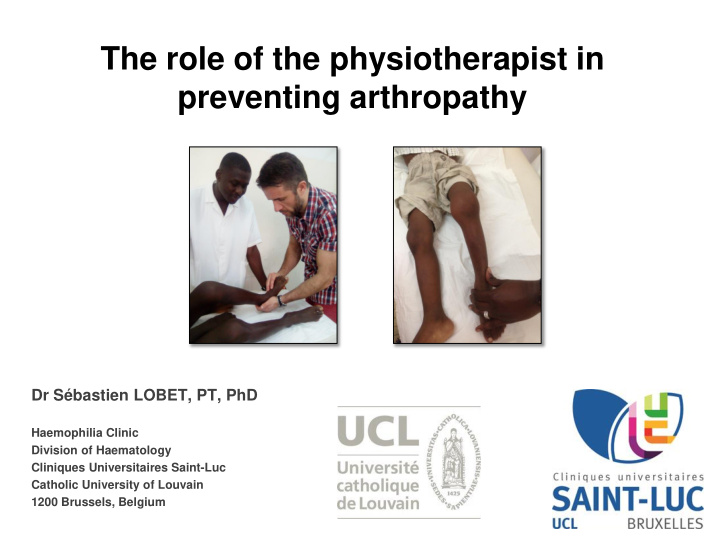



The role of the physiotherapist in preventing arthropathy Dr Sébastien LOBET, PT, PhD Haemophilia Clinic Division of Haematology Cliniques Universitaires Saint-Luc Catholic University of Louvain 1200 Brussels, Belgium
The most affected joints in haemophilia • 90% of bleeding episodes affect the musculoskeletal system • Up to 80% of bleeds occur in ankles, knees and elbows • 10% are haematomas • Bleeding episodes often begin by 2 years of age Image provided by S. Lobet. Lobet S, et al. J Blood Med 2014;5:207 – 18.
The roles of physiotherapist in Hemophilia Treatment Centre Hematology department Pediatric Orthopedic Physiotherapist department department Physical medicine department
The roles of the physiotherapist in the Haemophilia Treatment Centre Joint assessment Link with the local Physiotherapy physiotherapist session Identify Orthosis candidates for prescription surgery Education of non- Research haematological treatment Sports advice Images provided by S. Lobet.
Importance of (bi)annual assessment • Ensure that bleeds have resolved completely • Assess small changes over time • Watch for new problems (deformity, loss of range of motion, compensatory movement patterns) • Explain surgery / conservative treatments in comprehensive terms! • Opportunity for contact with the local physiotherapist / teacher / coach • Give advice in sports participation • … Call the physiotherapist before small problems become big ones!
Treatment of the acute phase R eplacement of clotting factors R est (Immobilisation) I ce? C ompression (except psoas) E levation Forsyth AL, et al. Haemophilia 2012;18:843 – 50. Hermans C, et al. Haemophilia 2011;17:383 – 92. Blankenship CS, et al. J Manag Care Pharm 2014;20:151 – 8.
Treatment of the chronic phase Interleukin-1 Interleukin-6 TNF-alpha Images provided by S. Lobet.
Example of a forced dorsiflexion manipulation * Images provided by S. Lobet.
Use of orthopaedic manual therapy in haemophilia care Elbow Talo-crural Elbow flexion extension dorsiflexion Images provided by S. Lobet. Hidalgo B, et al. J Manipulative Physiol Ther 2014;37:105 – 15; Hidalgo B, et al. J Man Manip Ther 2014;22:59 – 74. Cuesta-Barriuso R, et al. Physiother Theory Pract 2014;30:534 – 39.
Joint disease: a major consequence of overweight and obesity in people with haemophilia • Obesity and increased weight load may precipitate increased joint bleeds 1 • Decrease in the rates of joint bleeds with weight reduction 1 • General population: knee osteoarthritis increased 5 x in men with BMI 30 –35 Vs BMI ˂ 25 2 • Obesity is also a risk factor for non-bearing joints 2 1. Majumdar et al. Haemophilia 2012 May;18(3):e82-4. 2. Yusuf E, et al. Ann Rheum Dis 2010;69:761 – 5
Specific recommendations for paediatric consultations 1. Choose an appropriate sport TOGETHER! 2. Minimise the risk of injury 3. Evaluate the possible consequences of a bleed Images provided by S. Lobet.
It is important to promote simple and inexpensive conservative treatments Money can be saved Adapted footwear Images provided by S. Lobet.
The value of physiotherapy: Words of wisdom “I am weary of ‘prophylaxis’ that consists of concentrate alone” “I suspect prophylactic physiotherapy would potentiate concentrate prophylaxis, preventing haemorrhages and saving money” Dr Carol K. Kasper Image provided by S. Lobet.
Creation of the EAHAD Physiotherapy Group July 2015 February 2017 Images provided by S. Lobet.
20 75 4 15 3 7 5 4 7 24 16 5 3 5
Recommend
More recommend